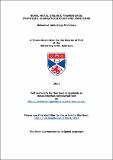Files in this item
Novel metal organic frameworks : synthesis, characterisation and functions
Item metadata
| dc.contributor.advisor | Morris, Russell Edward | |
| dc.contributor.author | Haja Mohideen, Mohamed Infas | |
| dc.coverage.spatial | 303 | en_US |
| dc.date.accessioned | 2011-06-22T15:08:28Z | |
| dc.date.available | 2011-06-22T15:08:28Z | |
| dc.date.issued | 2011-05-20 | |
| dc.identifier | uk.bl.ethos.552596 | |
| dc.identifier.uri | https://hdl.handle.net/10023/1892 | |
| dc.description.abstract | The synthesis and properties of novel Metal Organic Frameworks were investigated and reported in this thesis. Thirteen new materials have been synthesized and their properties have been discussed with nine of the structures being solved. The most interesting and useful MOF among the thirteen materials is STAM-1, a copper-based Metal Organic Framework in which the starting linker (Benzene-1,3,5-tricarboxylic acid) undergoes selective in situ monoesterification during the synthesis. The monoesterified BTC can be recovered easily from the MOF, opening up MOF synthesis as a “protection” tool for unexpected selectivity in preparative chemistry that is difficult to accomplish using standard organic chemistry approaches. The selective linker derivatisation leads to the formation of a porous MOF with two types of accessible channel; one hydrophilic lined by copper and the other hydrophobic, lined by the ester groups. The unique structure of the pores leads to unprecedented adsorption behaviour, which reacts differently to gases or vapours of dissimilar chemistry and allows them to access different parts of the structure. The structural flexibility of STAM-1 shows significant differences in the kinetics of O₂ and N₂ adsorption, showing potential for new materials to be developed for air separation. Having two types of channel systems, adsorption can be switched between the two channels by judicious choice of the conditions; a thermal trigger to open the hydrophilic channel and a chemical trigger to open the hydrophobic channel. The storage and release capability of NO in STAM-1 was investigated for use in biomedical applications. Successful studies showed the strength of the antibacterial effects of NO loaded STAM-1, by using three different bacterial strains as a test of performance and were found to be bactericidal. Furthermore the antibacterial effects of NO free STAM-1 were also probed and found to be bactericidal even with low concentrations of the material such as 5 wt%. STAM-1 showed some complex magnetic behaviour by displaying strong antiferromagnetic properties at room temperature and ferromagnetic properties at lower temperatures. The antiferromagnetic coupling was observed within the dimer and ferromagnetic coupling between the dimers. This property of ferromagnetism can only be attributed to the corporation of magnetic dimers in the framework. STAM-2 displays a different magnetic behaviour than STAM-1 which shows paramagnetic properties at room temperature and antiferromagnetic properties at lower temperatures. Other novel MOFs were also successfully characterised and their properties were investigated for potential applications. | en_US |
| dc.language.iso | en | en_US |
| dc.publisher | University of St Andrews | |
| dc.subject | MOFs | en_US |
| dc.subject | Switchable channels | en_US |
| dc.subject.lcc | QD382.C67H2 | |
| dc.subject.lcsh | Coordination polymers--Synthesis | en_US |
| dc.subject.lcsh | Coordination polymers | en_US |
| dc.subject.lcsh | Organometallic polymers | en_US |
| dc.subject.lcsh | Porous materials | en_US |
| dc.title | Novel metal organic frameworks : synthesis, characterisation and functions | en_US |
| dc.type | Thesis | en_US |
| dc.type.qualificationlevel | Doctoral | en_US |
| dc.type.qualificationname | PhD Doctor of Philosophy | en_US |
| dc.publisher.institution | The University of St Andrews | en_US |
This item appears in the following Collection(s)
Items in the St Andrews Research Repository are protected by copyright, with all rights reserved, unless otherwise indicated.

